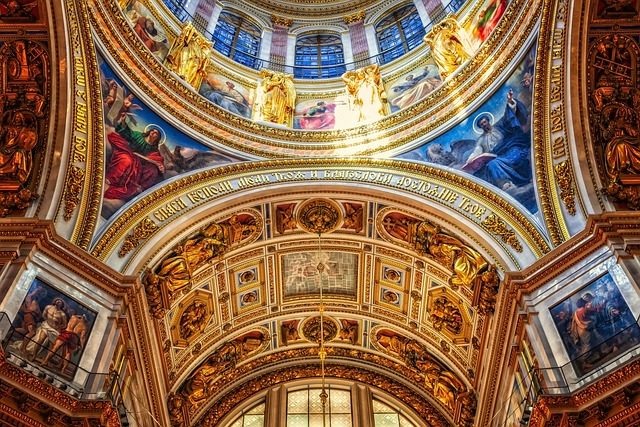When considering matters of faith and religious affiliation, individuals often find themselves contemplating which path to follow. One common dilemma is choosing between Orthodoxy and Catholicism. Both Orthodox Christianity and Catholicism share similarities in their beliefs and practices, yet they also have distinct differences. This decision ultimately depends on personal beliefs, cultural background, and individual spiritual needs. It is important to thoroughly research and reflect upon the teachings, traditions, and values of both Orthodox and Catholic faiths before making a decision.
Table of Contents
Key Differences Between Orthodox and Catholic Beliefs and Practices
Are you feeling torn between the Orthodox and Catholic faiths? It’s not uncommon to find yourself in this predicament, as both religions have rich histories and devout followers. While they share many similarities, there are also key differences between Orthodox and Catholic beliefs and practices that may help you make a decision.
One of the most significant differences between the two is the issue of papal authority. In the Catholic Church, the Pope is considered the head of the Church and has the final say on matters of doctrine and faith. On the other hand, the Orthodox Church does not recognize the Pope as having this authority. Instead, they believe in a collective leadership structure, with each bishop having equal authority within their respective regions.
Another difference lies in the way the two churches approach the concept of original sin. Catholics believe that all humans inherit the original sin of Adam and Eve and must be baptized to cleanse themselves of this sin. In contrast, Orthodox Christians believe that while humans are affected by the consequences of original sin, they do not inherit the guilt associated with it. Instead, they focus on the process of theosis, which is the gradual transformation of individuals to become more like God.
The issue of the Filioque clause also sets the two churches apart. This clause, added to the Nicene Creed by the Catholic Church, states that the Holy Spirit proceeds from both the Father and the Son. Orthodox Christians, however, believe that the Holy Spirit proceeds only from the Father. This theological difference has been a point of contention between the two churches for centuries.
When it comes to worship practices, there are noticeable distinctions as well. Catholic liturgy tends to be more uniform and centralized, with the Mass being the central act of worship. The Orthodox Church, on the other hand, places a greater emphasis on the Divine Liturgy, which is seen as a participation in the heavenly worship. Orthodox worship is often characterized by its rich symbolism, elaborate rituals, and the use of icons.
The role of icons is another area where the two churches differ. While both Orthodox and Catholic churches use icons in their worship, the Orthodox Church places a greater emphasis on their veneration. Icons are seen as windows to the divine and are believed to have the ability to connect believers with the spiritual realm. Catholics, on the other hand, view icons as aids to devotion but do not venerate them in the same way.
Ultimately, the decision between Orthodoxy and Catholicism is a deeply personal one. It’s important to consider not only the theological differences but also the cultural and historical contexts of each tradition. If you’re drawn to a more centralized authority and uniform worship, Catholicism may be the right fit for you. On the other hand, if you value a collective leadership structure and a more mystical approach to worship, Orthodoxy may be the path to explore.
Remember, both Orthodox and Catholic Christians share a common faith in Jesus Christ and strive to live a life of love and devotion. Whichever path you choose, it’s essential to approach your decision with an open heart and a willingness to grow in your relationship with God.
Exploring the Historical Split: Orthodox and Catholic Churches

When it comes to choosing a religious path, many people find themselves torn between the Orthodox and Catholic churches. Both have rich histories and deep spiritual traditions, making the decision a difficult one. In order to make an informed choice, it’s important to explore the historical split between these two branches of Christianity.
The split between the Orthodox and Catholic churches dates back to the 11th century, known as the Great Schism. At that time, the Christian world was divided into two major centers of power: Rome in the West and Constantinople (now Istanbul) in the East. The primary cause of the split was a disagreement over the authority of the Pope, the Bishop of Rome.
The Catholic Church believed that the Pope held supreme authority over all Christians, both in matters of faith and in the governance of the Church. On the other hand, the Orthodox Church believed in a more decentralized structure, with each bishop having equal authority within his own diocese. This fundamental difference in governance led to a growing divide between the two churches.
Another point of contention was the use of icons in worship. The Orthodox Church embraced the use of icons, believing that they served as windows to the divine and aids to prayer. However, some within the Catholic Church saw the veneration of icons as idolatry, leading to further tension between the two branches.
Over time, these differences in theology and governance became more pronounced, leading to the formal split in 1054. The Catholic Church in the West became known as the Roman Catholic Church, while the Eastern Church became known as the Orthodox Church.
Despite the split, both the Orthodox and Catholic churches share many similarities. They both believe in the Holy Trinity, the divinity of Jesus Christ, and the importance of sacraments. Both also have a rich liturgical tradition, with elaborate rituals and ceremonies that are meant to inspire awe and reverence.
However, there are also some key differences between the two. One of the most noticeable differences is in the style of worship. Orthodox services are known for their elaborate and mystical rituals, with a heavy emphasis on chanting and incense. Catholic services, on the other hand, tend to be more structured and formal, with a greater emphasis on the Eucharist.
Another difference lies in the role of the Pope. While the Pope is considered the spiritual leader of the Catholic Church, the Orthodox Church does not recognize his authority. Instead, each Orthodox Church is governed by its own patriarch or metropolitan, who is considered equal in authority to other bishops.
Ultimately, the decision between Orthodoxy and Catholicism is a deeply personal one. It’s important to consider your own spiritual needs and beliefs, as well as the traditions and practices that resonate with you. Both churches offer a rich spiritual heritage and a path to salvation, so it’s worth taking the time to explore and reflect on what feels right for you.
Comparing Orthodox and Catholic Liturgical Traditions
When it comes to choosing a religious tradition, many people find themselves torn between the Orthodox and Catholic faiths. Both traditions have rich histories and deep spiritual practices that can be appealing to those seeking a closer connection with God. In this article, we will explore the similarities and differences between Orthodox and Catholic liturgical traditions to help you make an informed decision.
One of the main similarities between Orthodox and Catholic liturgical traditions is their emphasis on ritual and symbolism. Both traditions place great importance on the sacraments, such as baptism and the Eucharist, as a means of experiencing God’s grace. In both Orthodox and Catholic churches, you will find priests wearing ornate vestments, the use of incense, and the presence of icons and statues to aid in worship.
However, there are also some key differences between the two traditions. One of the most noticeable differences is the language used during worship. In the Orthodox tradition, services are primarily conducted in Greek, Russian, or other ancient languages, depending on the cultural background of the church. On the other hand, Catholic services are often conducted in the local language, allowing for a greater understanding of the prayers and readings.
Another significant difference lies in the structure of the liturgy itself. Orthodox liturgies tend to be longer and more elaborate, with a greater emphasis on chanting and singing. The use of icons is also more prevalent in Orthodox churches, with worshippers often kissing and venerating these sacred images. In contrast, Catholic liturgies are generally shorter and more straightforward, with a greater emphasis on the homily and the reading of Scripture.
The role of the clergy is another area where Orthodox and Catholic traditions differ. In the Orthodox Church, priests are allowed to marry before ordination, while in the Catholic Church, priests are required to take a vow of celibacy. This distinction can have an impact on the way the clergy interacts with their congregations and the expectations placed upon them.
When it comes to the celebration of the Eucharist, both traditions hold a deep reverence for this sacrament. However, there are some differences in the way it is administered. In the Orthodox tradition, the bread and wine are believed to become the actual body and blood of Christ through a process known as transubstantiation. In the Catholic tradition, the belief is similar, but the term used is “consubstantiation.” These theological nuances may not be immediately apparent to the casual observer, but they can have a significant impact on one’s spiritual journey.
Ultimately, the decision between Orthodox and Catholic liturgical traditions is a deeply personal one. It is important to consider your own spiritual needs and preferences, as well as the cultural and historical context in which each tradition developed. Both traditions offer a rich and meaningful way to connect with God and participate in the life of the Church. Whether you choose to be Orthodox or Catholic, what matters most is the sincerity of your faith and your commitment to living a life of love and service to others.
Considering Orthodox and Catholic Approaches to Authority and Leadership
When it comes to choosing a religious path, many people find themselves torn between the Orthodox and Catholic traditions. Both have rich histories and deep spiritual practices, making the decision a difficult one. One important aspect to consider is the approach to authority and leadership within each tradition.
In the Orthodox Church, authority is seen as something that is passed down through the ages. The bishops, who are considered the successors of the apostles, hold the highest authority within the Church. They are responsible for maintaining the teachings and traditions that have been handed down since the time of Christ. This emphasis on tradition and continuity can be comforting for those seeking a sense of stability and a connection to the early Church.
On the other hand, the Catholic Church places a strong emphasis on the authority of the Pope. As the successor of Saint Peter, the Pope is believed to have a direct line of authority from Christ himself. This centralized authority provides a clear structure and hierarchy within the Church. For those who value a strong leadership figure and a clear chain of command, Catholicism may be the preferred choice.
It is important to note that both traditions have a strong sense of community and a belief in the importance of the Church as a whole. In the Orthodox Church, decisions are often made through a process of consensus among the bishops, while in the Catholic Church, the Pope is seen as the ultimate authority in matters of doctrine and faith. However, both traditions value the input and participation of the faithful in the life of the Church.
Another factor to consider is the approach to liturgy and worship. In the Orthodox Church, the liturgy is often seen as a mystical and transcendent experience. The use of icons, incense, and chant creates a sense of awe and reverence. The focus is on the mystery of God’s presence and the participation of the entire congregation in the worship service.
In contrast, the Catholic Church places a greater emphasis on the sacraments, particularly the Eucharist. The Mass is seen as a reenactment of Christ’s sacrifice and a means of receiving his grace. The liturgy is often more structured and formal, with a greater emphasis on ritual and symbolism. For those who value a more structured and sacramental approach to worship, Catholicism may be the preferred choice.
Ultimately, the decision between Orthodoxy and Catholicism is a deeply personal one. It is important to consider your own spiritual needs and preferences, as well as the community and support system that each tradition offers. Both traditions have a rich spiritual heritage and a deep commitment to the teachings of Christ. Whether you choose to be Orthodox or Catholic, the most important thing is to seek a relationship with God and to live out your faith in a way that is meaningful to you.
Conclusion
The decision of whether to be Orthodox or Catholic ultimately depends on an individual’s personal beliefs, values, and religious preferences. It is important to thoroughly research and understand the teachings, practices, and traditions of both Orthodox and Catholic Christianity before making a decision. Seeking guidance from religious leaders and engaging in meaningful discussions with members of both communities can also provide valuable insights. Ultimately, the choice should be based on what resonates most with one’s spiritual journey and fosters a deep connection with God.
For licensing reasons, we must provide the following notice: This content was created in part with the help of an AI.


